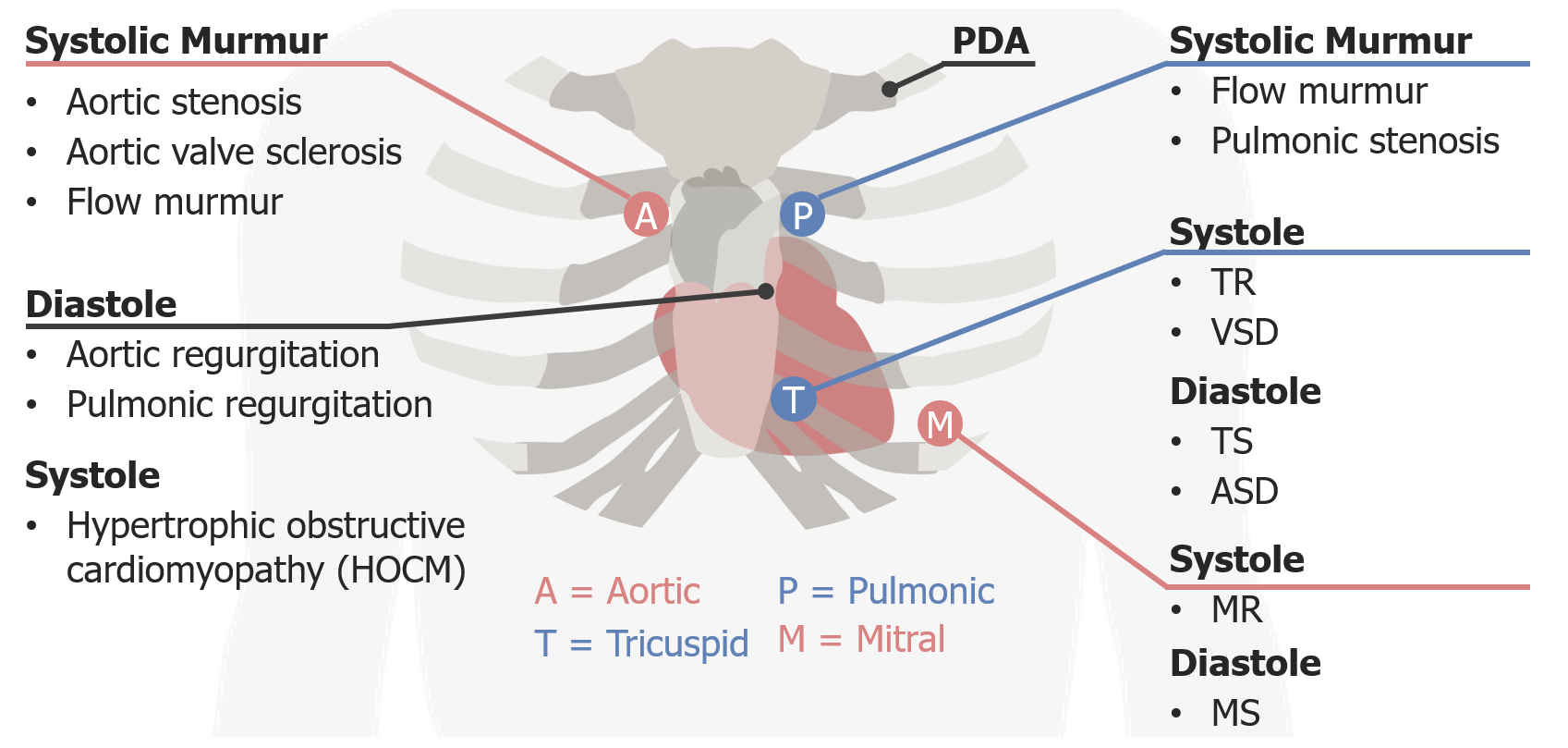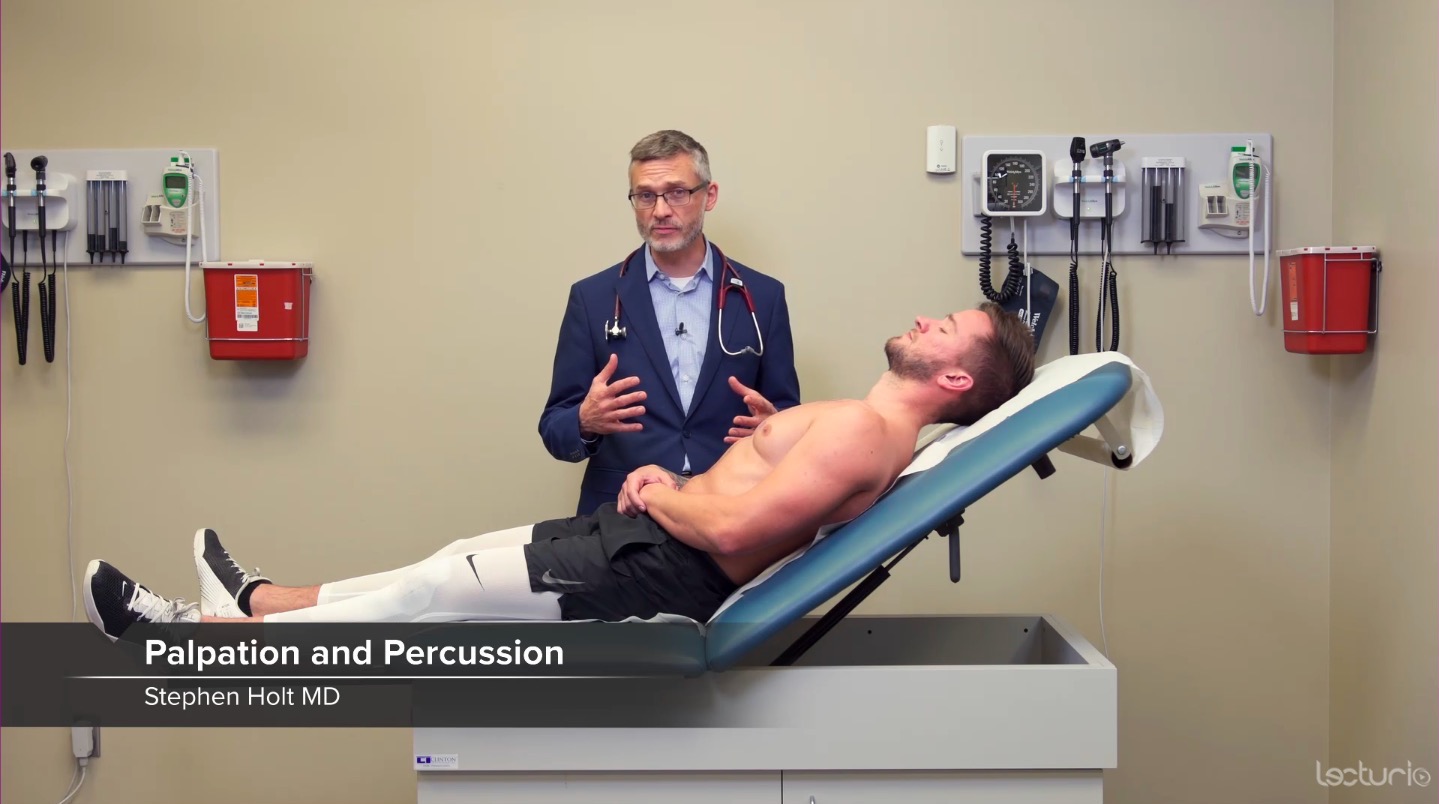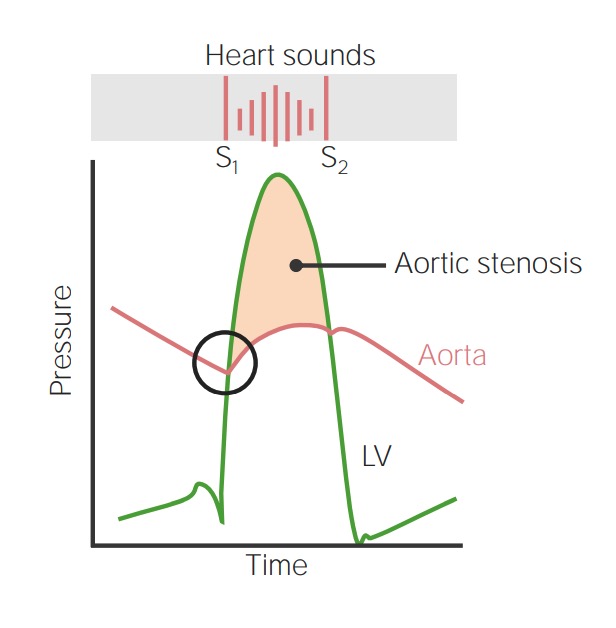Playlist
Show Playlist
Hide Playlist
Aortic Stenosis – Systolic Murmurs
-
Reference List Physical Examination.pdf
-
Download Lecture Overview
00:01 First up, the murmur of aortic stenosis. 00:04 So aortic stenosis, it's a problem with the aortic valve, so you might presume then that the aortic area would be the most likely place to hear in aortic stenosis murmur, and while that's generally true, the aortic stenosis murmur amongst all the other murmurs, has the tendency to migrate. 00:23 So actually, the aortic stenosis murmur may be heard all the way across the precordium even down here to the apex, in sort of a sash like pattern. 00:32 So just because you heard the murmur best all the way over here, does not mean it's not aortic stenosis - so that's the location. 00:38 Intensity, an important feature about aortic stenosis murmur is that the intensity does not really help us to discern the severity of somebody's aortic stenosis murmur or aortic stenosis disease. 00:50 Some patients may have a very subtle soft murmur maybe a 1 or 2 out of 6, but they could actually have severe critical aortic stenosis, so it's not a great guide for this particular murmur. 01:02 Next up would be the shape and the pitch. 01:07 So the classic description for the aortic stenosis murmur is the so called crescendo-decrescendo murmur and you know cardiologist for many, many years have tried to use onomatopoeia which is a way of trying to come up with a name to describe a sound by making that sound with your mouth to describe certain murmurs like before when I said lub-dub and balubdub and lubdidub, those are, it's basically onomatopoeia. The same thing applies with heart murmurs. 01:37 So the classic way to attempt to recreate the sound or the murmur of your stenosis described as of course harsh sound like you're clearing your throat so it might sound something like this [making a sound]. 01:54 And you can hear there's a crescendo-decrescendo quality to the sound that I'm trying to recreate, it's a mixture of high and low pitched sounds and I'll just do it again, you're going to hear it anywhere in this area [making a sound]. 02:09 Lastly, in terms of the timing, a systolic murmur of aortic stenosis can be either early, mid, or in late systole. 02:18 In theory, the lateness of the aortic stenosis murmur does, to some extent, correlate with the severity of aortic stenosis. 02:27 I could confess that I often times can't distinguish if a murmur is early or late systole, but that doesn't mean that you shouldn't try. 02:36 In addition, aortic stenosis murmur has a few other cardinal features. 02:39 First off, it turns out that when somebody has severe aortic stenosis, the second heart sound may actually be less crisp. 02:49 If you think of it this way, if the aortic heart valve, the tricuspid valve, is really degenerating, it's not going to close as crisply if there's all these sclerotic tissue on it, so since the S2 is based on the closure of that tricuspid valve, you may lose that sound particularly the A2 component of the S2 when you're auscultating somebody who has critical aortic stenosis. 03:12 So that's one feature, it's the loss of A2 right over the aortic area. 03:16 The second thing is that many murmurs radiate to other locations and then in this case since we're talking about blood shooting out of the aortic outflow tract and up into the carotids, we ought the be able to hear this murmur up in the carotids, so when I think somebody has an aortic stenosis murmur, I listen with my diaphragm over the right carotid and the left carotid, and typically a patient with aortic stenosis should have a rush of this murmur or even a bruit sound heading into the right carotid artery in particular. 03:58 Remember that the aorta is a direct conduit up to right internal carotid artery, as opposed to having to make a quick right turn and a left turn to get up to the left carotid artery. 04:11 So you're more likely to hear the radiating into the carotids on the right side, those certainly you can hear them both sides as well. 04:18 The last thing I'll add about aortic stenosis is that in addition to being able to find the stenosis or the murmur radiating into the carotids, because the aortic stenosis is so significant and it's occluding the outflow tract its causing blood to have a little bit more trouble getting out into the peripheral vascular system. 04:42 As such, there's something called pulsus parvus et tardus, which is - this idea that rather than the left ventricle immediately ejecting all these blood and being able to fill it out here to radial pulse, there's actually a bit of a delay. 04:54 Number one, there's a delay in the upstroke in the carotids, so you can listen down her at the apex. 05:03 I know that left ventricular contraction is happening as soon as I hear the mitral valve close, so that's the beginning of systole, but up here, I may find that here's a little bit of a delay between when I hear S1 occur and when I feel the carotid artery pulsation in my fingertips, and that's called pulsus parvus et tardus, the tardus means late, the parvus part simply means that it's a little bit flat and attenuated. 05:32 The same thing applies with listening to the heart here and simply checking the pulse, you may find there's a delay between the apex of the heart and the pulsation in the radial artery and that's called the apical radial delay, which is one of the potential findings you may see in advanced aortic stenosis.
About the Lecture
The lecture Aortic Stenosis – Systolic Murmurs by Stephen Holt, MD, MS is from the course Examination of Cardiovascular and Respiratory System.
Included Quiz Questions
Which of the following is the MOST accurate description of the murmur of aortic stenosis?
- It is usually heard at the right upper sternal border but also can be heard across the precordium during systole.
- It is usually heard at the left lower sternal border during diastole and may radiate to the apex.
- It is heard anywhere in the chest during diastole.
- It is heard during systole, and the intensity of the murmur correlates with the degree of stenosis.
- It is usually heard during diastole, and the intensity of the murmur does not correlate with the degree of stenosis.
How does valvular aortic stenosis affect the S2 heart sound?
- S2 is heard less crisply, as the A2 component is affected by degenerating sclerotic tissue.
- S2 is heard more crisply, as the A2 component is affected by degenerating sclerotic tissue.
- S2 is heard more crisply, as the P2 component is affected by degenerating sclerotic tissue.
- S2 is heard less crisply, as the P2 component is affected by degenerating sclerotic tissue.
- Aortic stenosis causes splitting of the S2 heart sound, which is heard more easily.
What is TRUE regarding the term "pulsus parvus et tardus" in relation to aortic stenosis?
- The pulse is weak and late relative to the contraction of the heart.
- It is caused by a floppy aortic valve making it progressively looser when it opens.
- The pulse rises quickly and rapidly.
- The weak and late pulse is due to increased blood flow through the aortic valve.
- Pulsus parvus et tardus is seen in both aortic and mitral valve stenosis.
Customer reviews
4,0 of 5 stars
| 5 Stars |
|
0 |
| 4 Stars |
|
1 |
| 3 Stars |
|
0 |
| 2 Stars |
|
0 |
| 1 Star |
|
0 |
1 customer review without text
1 user review without text






